Is That Fly a Nymph? A Look At Insect Life Cycles
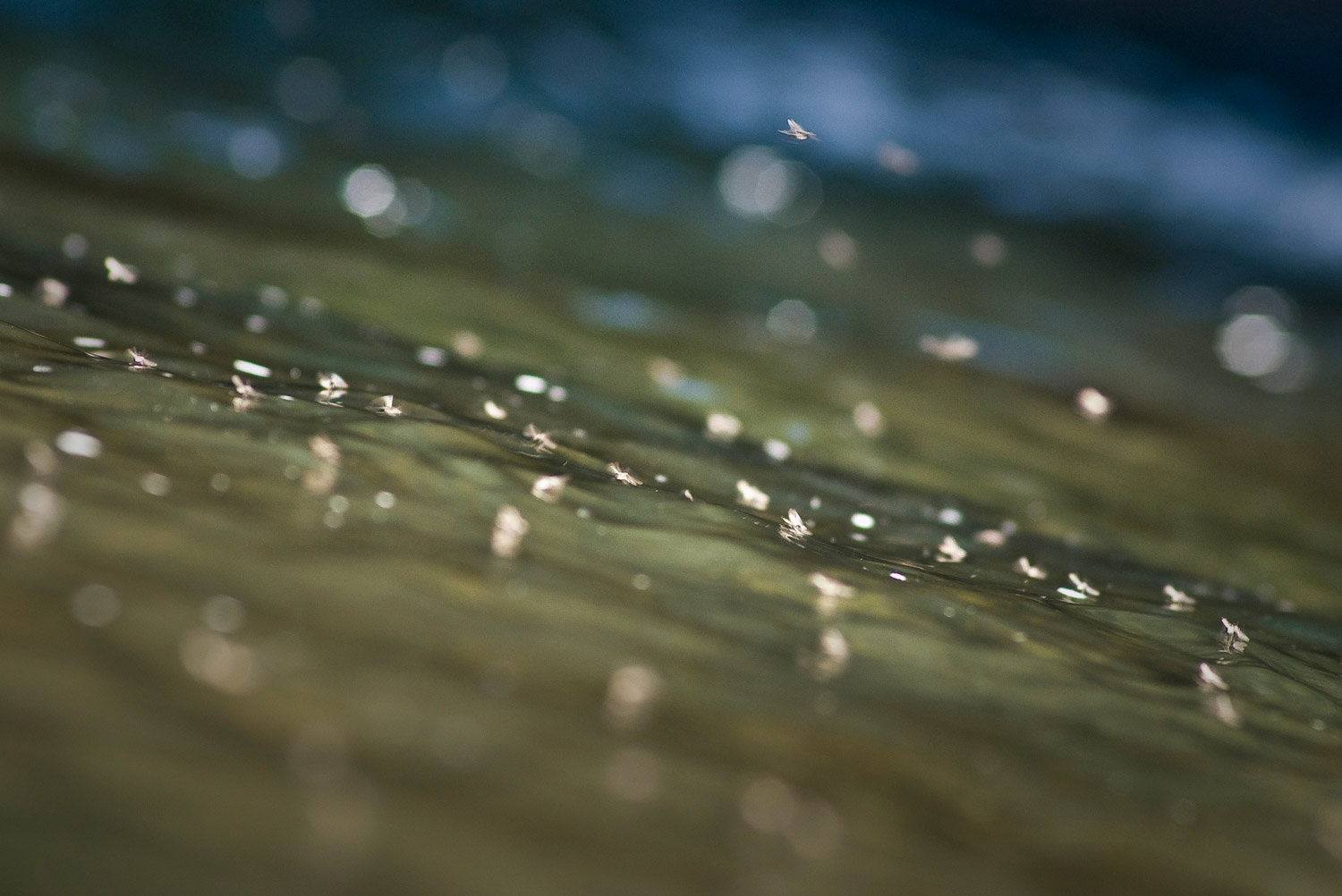
IS THAT FLY A NYMPH? THAT’S THE QUESTION I GOT FROM A READER THE OTHER DAY.
A fair question from a guy who’s only fly fished for redfish and isn’t familiar with trout flies. A simple question with a very complicated answer. Complicated enough that I figured it deserved an explanation, and why not share it.
The fly in question was a midge pattern, so technically not a nymph.
The word “nymph” however, like so many words, shares two meanings. The literal (denotative) meaning is a juvenile mayfly or stonefly in the subsurface phase of its life cycle. The word is also used to refer to flies that imitate these insects. Since a midge starts its life as a larva rather than a nymph, the flies that imitate them are not technically nymphs.
The word nymph also has a conversational (connotative) meaning. It is often used to refer to flies that are dead drifted below the surface. A San Juan Worm or an egg pattern is often referred to as a nymph because of the way they are fished. Some folks will use the term “wet fly” for any fly fished below the surface but this is not correct either. Wet flies are a specific style of fly intended to be fished in a different manner. So describing the midge fly as a nymph, while inaccurate, is not necessarily wrong. It can be fished as a nymph, connotatively.
I’m not generally one to engage in exercises of semantics but I believe there is more at stake here than clarity of the word. I know that when I first became aware of midge patterns many years ago, I was reluctant to fish them because
Read More »Fly Fishing with Stealth – 8 Common Mistakes
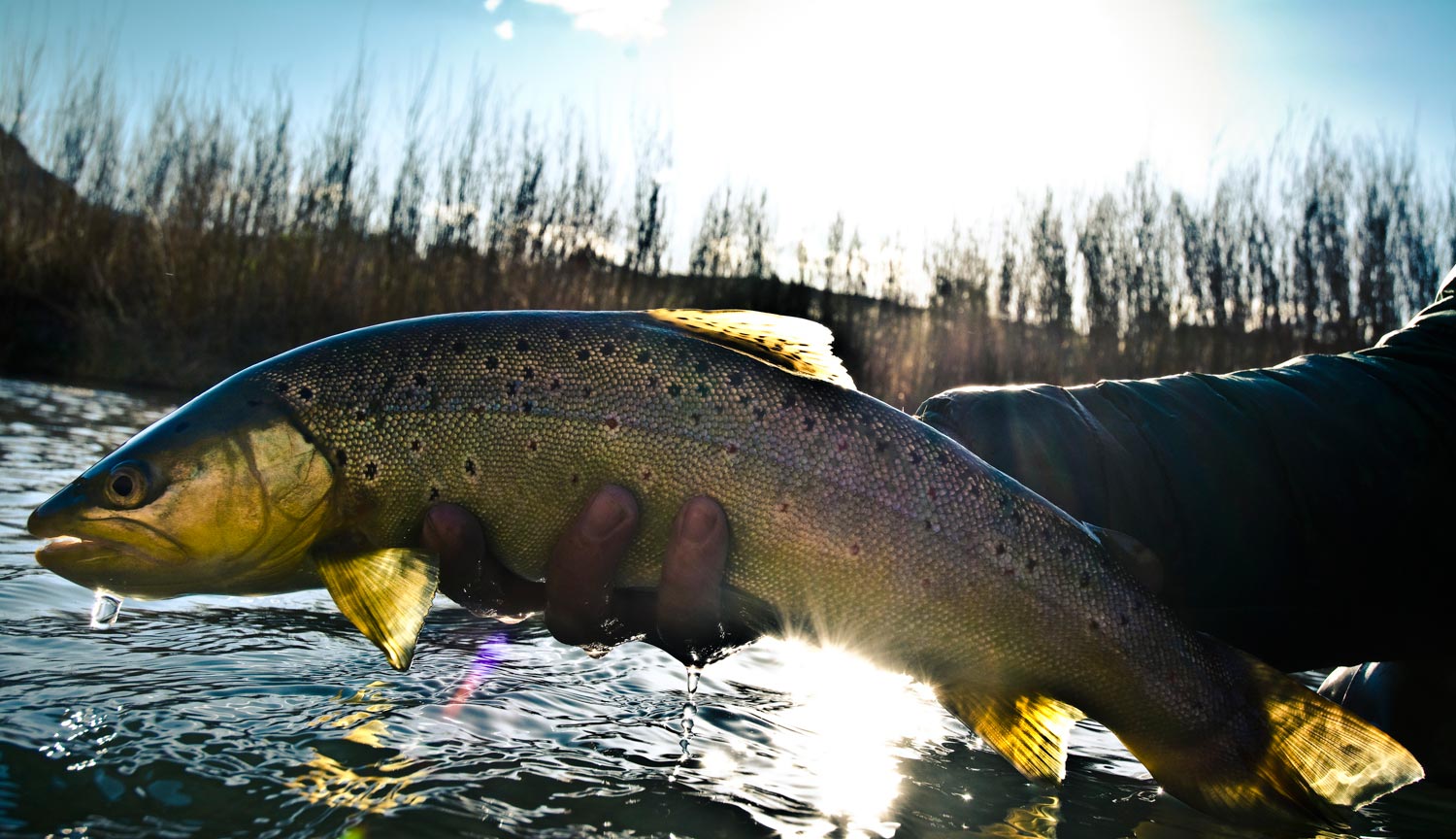
How often to you think anglers miss opportunities catching trout because of the lack of stealth?
The more educated trout populations are in a stream, river or lake you’re fly fishing, the more important it is for fly anglers to mimic the way a hunter stalks game in the field. I estimate that I give away upwards of 50% of my trout catching opportunities due to my lack of stealth. Below are 8 common mistakes fly anglers make on the water that blow their cover and success.
Read More »If You’re Not Looking For Trout, You’re Missing Out
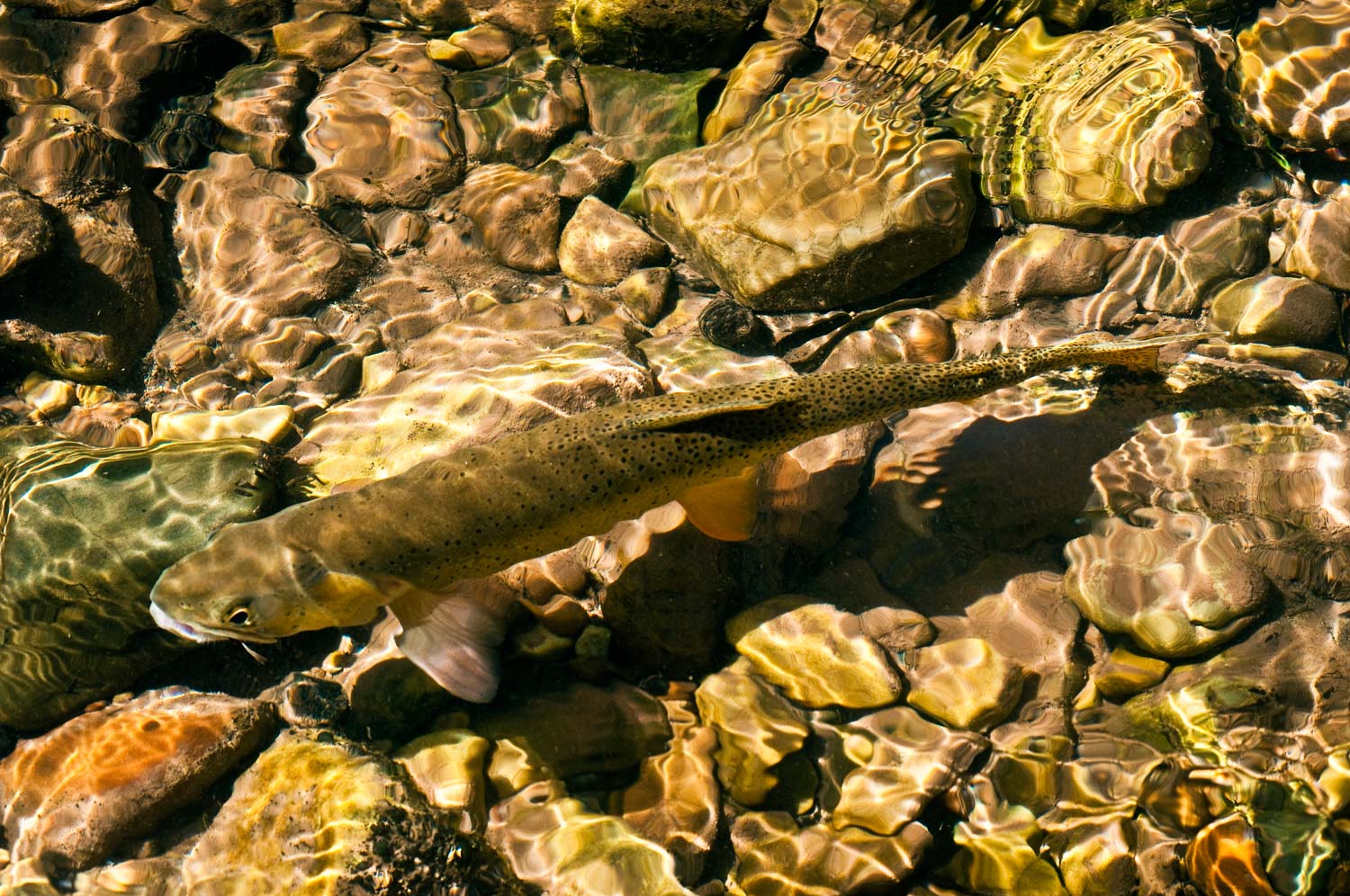
One of the things I always stress to my clients is the importance of always keeping an eye out for trout on the water. The first thing I do when I walk up to a prime piece of trout water, is take a minute or two to scan the water for dark shapes, shadows and subtle movements. I do it before I wet my fly or even my boots for that matter, because I know, if I can spot a trout, I’ll immediately double my chances at getting my rod bent. I also look for trout when I’m wading from one spot to the next. This is where many anglers mess up and get distracted by all the great looking water upstream of them, and then end up missing opportunities to spot and catch trout in transit. I used to spook a ton of trout myself moving from one fishing spot to the next. It still happens but not nearly as much because these days, when I’m on the move, I’m not in a hurry and I take plenty of time to look for trout as I wade.
You have to look for trout to spot them. They don’t shout, “hey, I’m over here”, or wave a white flag at you.
Read More »Fly Fishing: Is Guide Competition Good or Bad?
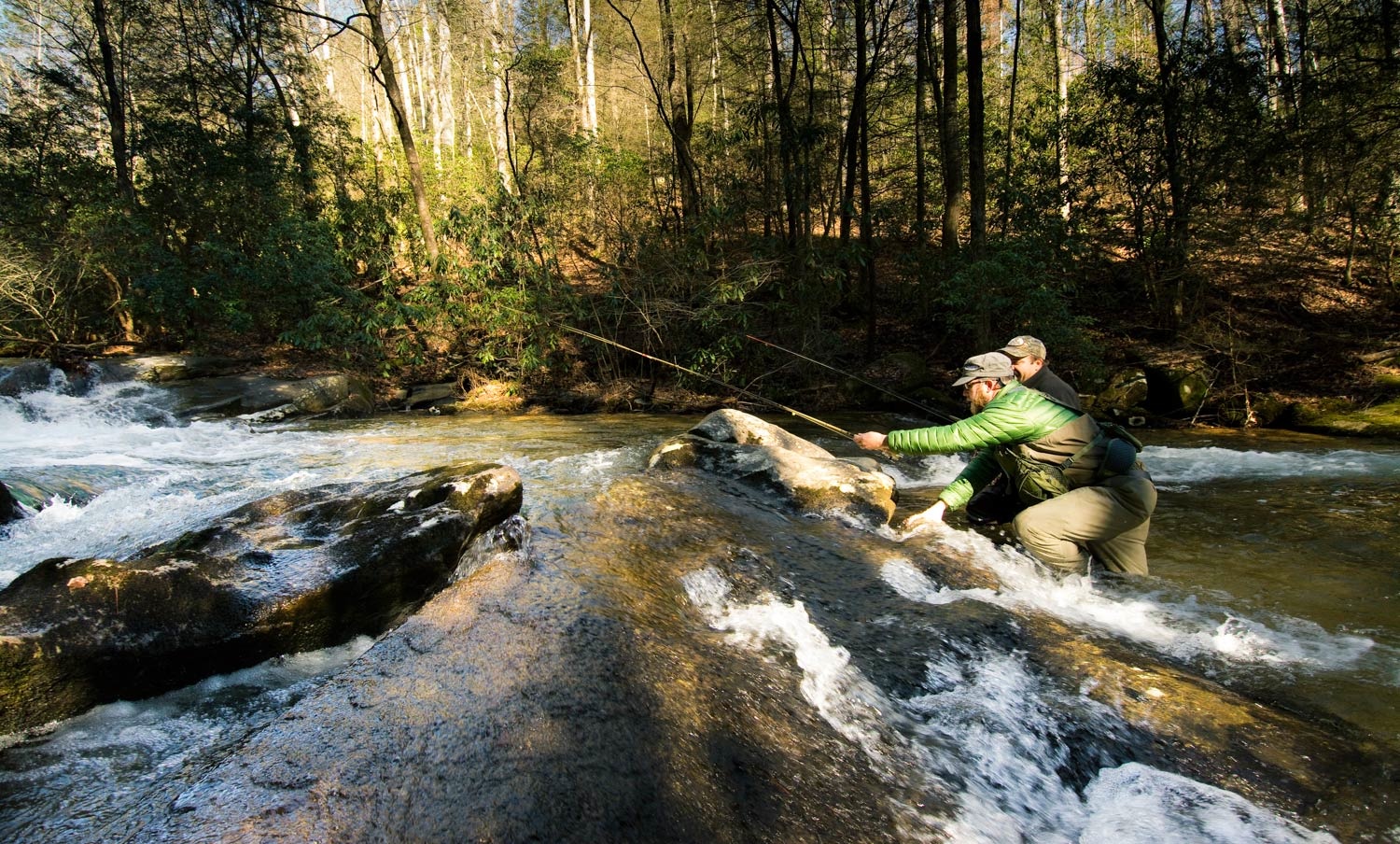
A few weeks ago, I chose to do something I never would have done, when I first started guiding. I made a point to accept an invitation from one of my local competitors to go fly fishing together. In the past, I would have passed the invitation up, thinking the competitor was trying to learn secrets of mine, or worse, had a hidden agenda aimed at harming my business, but that wasn’t the case at all. For a welcome change, we set aside all the nonsense of us worrying about being competitors, and for the first time, we genuinely got to know one another. We spent the day working our way up a beautiful section of wild trout water, and we took turns fly fishing, while the other watched and told memorable guide trip stories. It turned out to be a really fun day on the water. One I’m confident I won’t forget for a very long time.
In the end, ten years of insecurities and false perceptions had been put to rest after just four hours on the water fly fishing together. We both realized that we’d done nothing positive for our businesses by black balling and avoiding each other. In fact, we agreed that we probably ended up doing more harm, since there had been plenty of times over the years when we could have helped each other out in a pinch. During my 45-minute drive back home, I reflected on the day’s events and it made me think about how much stress I could have avoided over the years guiding, if I wouldn’t have spent so much time worrying about my competitors. It’s ok every now and again to keep track of what your competitors are up to, but you should never lose sight of the most important element of your business, which is the services you’re providing to your customers.
Read More »The Magic of Soft Hackles
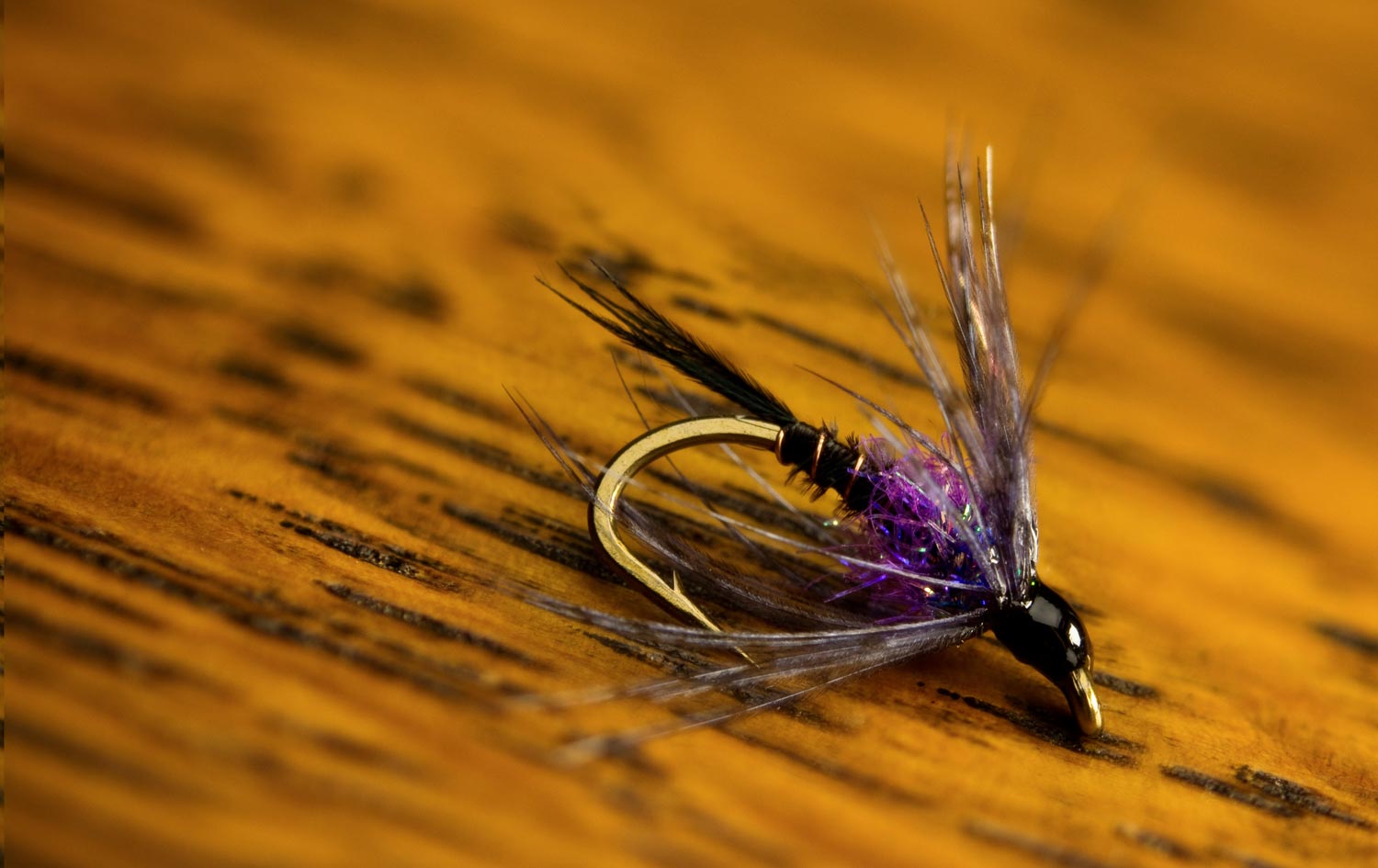
SOFT HACKLES ARE THE SHARKS OF THE FLY BOX.
Like the shark, the soft hackle is one of the oldest of its ilk, and like those ancient predators, it has evolved very little from its inception. Like the shark, it is a deadly design that could not be improved upon. Take, for example, the Kebari flies used by tenkara anglers for hundreds of years. Basically Soft Hackles with a reverse hackle. So effective, that traditional tenkara anglers only fish one pattern. Many modern fly anglers overlook traditional Soft Hackle patterns that are as effective today as ever.
There are two primary reasons for the effectiveness of the soft hackle. For starters, it’s the ultimate impressionistic pattern. It looks like almost everything on the aquatic menu. A fish who is looking for something specific is very likely to see it in a soft hackle. The second reason is, there’s just no wrong way to fish one. If you struggle with getting a drag free drift, a soft hackle is a very forgiving pattern. As long as it is in the water, it will produce fish.
FISHING SOFT HACKLES
As I said, there is no wrong way to fish these flies, but there are some proven tactics you can employ. For starters, dead drifting the fly as a nymph is never a bad plan. The Soft Hackle is as effective in this role as any pattern. That said, the dead drift does not take advantage of some of the pattern’s unique properties.
Perhaps the most common and most productive presentation for a Soft Hackle is the swing. The hackle has a tendency to trap an air bubble making the fly a natural emerger pattern. There are tying techniques, which I will go into, that enhance this effect. When fished deep and swung to the surface, the glowing air bubble inside the hackle is more than any trout can resist. One of my favorite ways to rig this pattern is to drop it about sixteen inches behind a Wooly Bugger with some weight in front of the Bugger. Drift the team deep through a run then lift them to the surface or quarter them down and across and let then swing and hold on.
When fishing from a boat, it’s very effective to cast a Soft Hackle straight across the current and retrieve it slowly, about four inches at strip. A hand-twist retrieve works well. This is also effective when teamed with a Bugger. Even more fun,
Read More »Fly Fishing in Gloves Gets Better with Time

DO YOU EVER FLY FISH IN GLOVES?
If you answered no, don’t make the mistake of thinking just because you tried fly fishing in gloves a couple times and couldn’t stand them, that you’ll always feel that way. Believe me, I been there, I used to be one of the haters myself. I’d rather have my fingers ice cold all day long than try to fly fish in gloves and feel awkward, clumsy and terrified I’m going to lose the fish of a lifetime. These things kept me from learning to fly fish comfortably in gloves for a very long time. It wasn’t until the last couple years that I’ve finally become comfortable fly fishing in gloves. In fact, it was my first steelhead trip to New York
Read More »When Rigging For Bonefish On The Fly, Less Can Be More
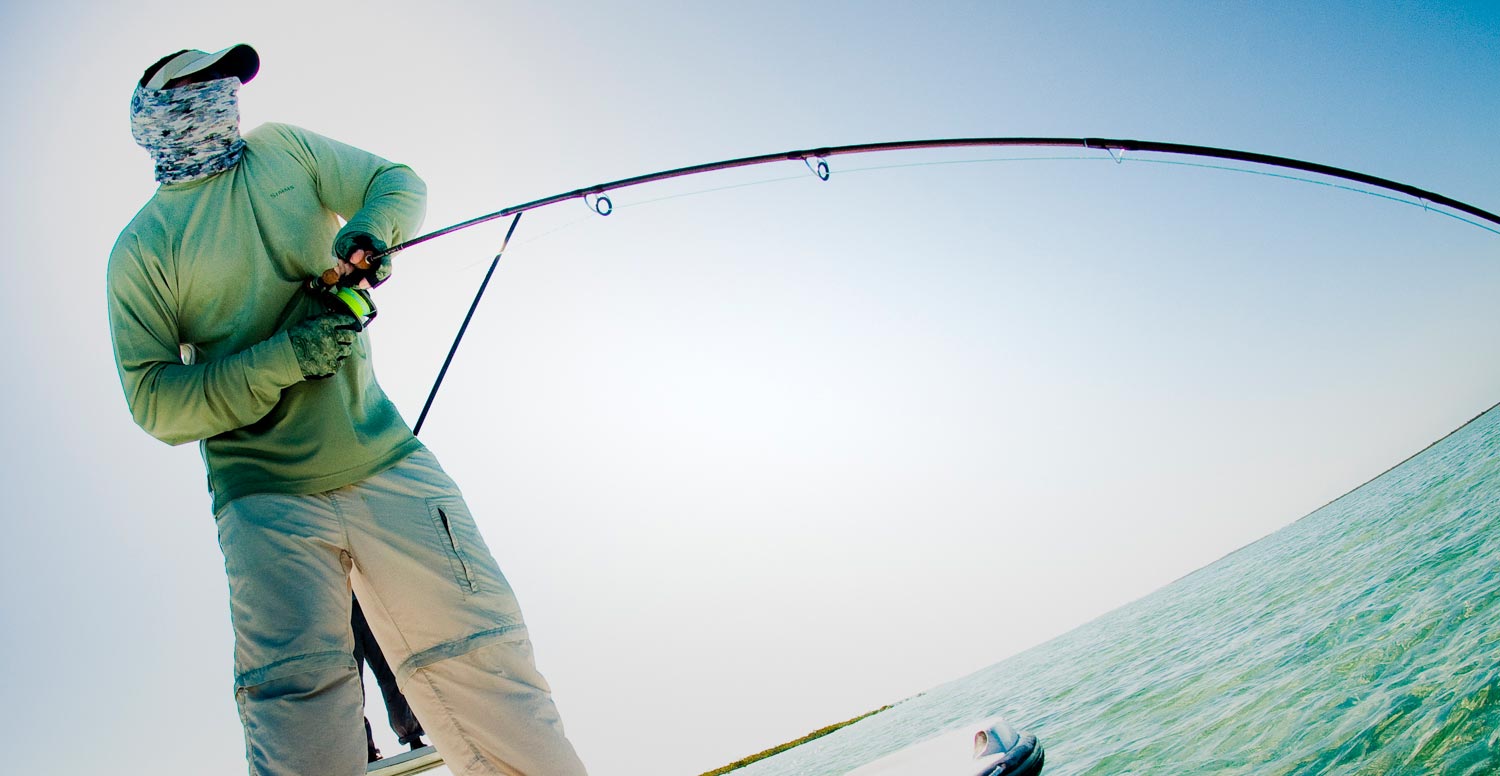
WHAT’S ALL THAT LINE REALLY DOING FOR YOU?
I got the chance recently to fish with my buddy Kristen Mustad from Nautilus Reels. I’m not sure Kristen ever fishes the same reel twice. And can you blame him? There’s always a new prototype to test and it is his job to never be satisfied with a reel. When Kristen lined up his new CCFX2 I noticed him doing something odd. He cut off about thirty feel of the back end of a brand new fly line. I had to ask way, and the answer made me rethink how I rig for bonefish.
“How often do you make a hundred and twenty foot cast?” Kristen asked me. “So the rest of the time, what’s that line doing? It’s creating drag in water when the fish cuts.” He makes a brisk gesture to the right with his hand to illustrate his point.
Bonefish are notorious for that. They will make a blistering run, putting you deep into your backing then make a ninety-degree turn. That’s often when they break off or straighten the hook. As they run at thirty-five mph, at ninety degrees to your line, all of that line is ripped through the water and the resulting pressure is far greater than the drag of your reel. It’s happened to me and it’s a bad feeling.
The pressure which the line puts on the fish is directly related to the diameter of the line. The thicker the line, the more pressure it puts on the fish and the greater the risk you will lose him. Fly line creates more drag than backing and that’s why Kristen cuts off the part of the line he’s not casting. Less fly line, less drag.
He takes it a step further though. Instead of using
Read More »Two Anglers Are Often Better Than One
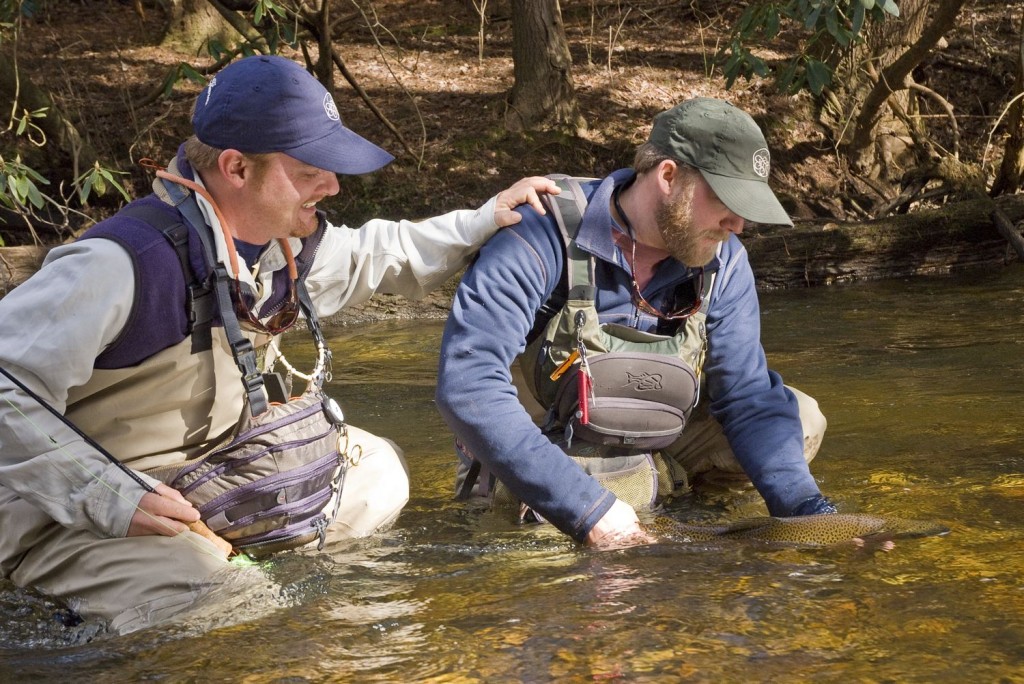
You can’t enjoy camaraderie on the water by yourself.
There’s no high-fives, no passing the victory flask around, and worst of all, it’s awfully hard to snap a quality photograph of you and a prized catch. Wait a minute, I take the latter back. It is possible to get a good photo by yourself if you’ve figured out a way to strap a tri-pod to your back and you’re also willing to lug it around all day. That being said, the main reason I think two anglers are often better than one, is because it allows you to work as a team, and that generally makes it much easier to find success on the water.
Louis and I have had pretty consistent success fishing together over the years. Even during really tough fishing conditions we generally find a way to put enough fish in the net during the day to call it a win. The biggest reason for this is because we’re always working together to decipher the fish code. Fishing as a team, we figure out what the fish are feeding on, where they’re primarily located, and what are the hot fly patterns. We make a point to never tie on the same patterns first thing in the morning, and quite often,
Read More »I’ll Have The Fish
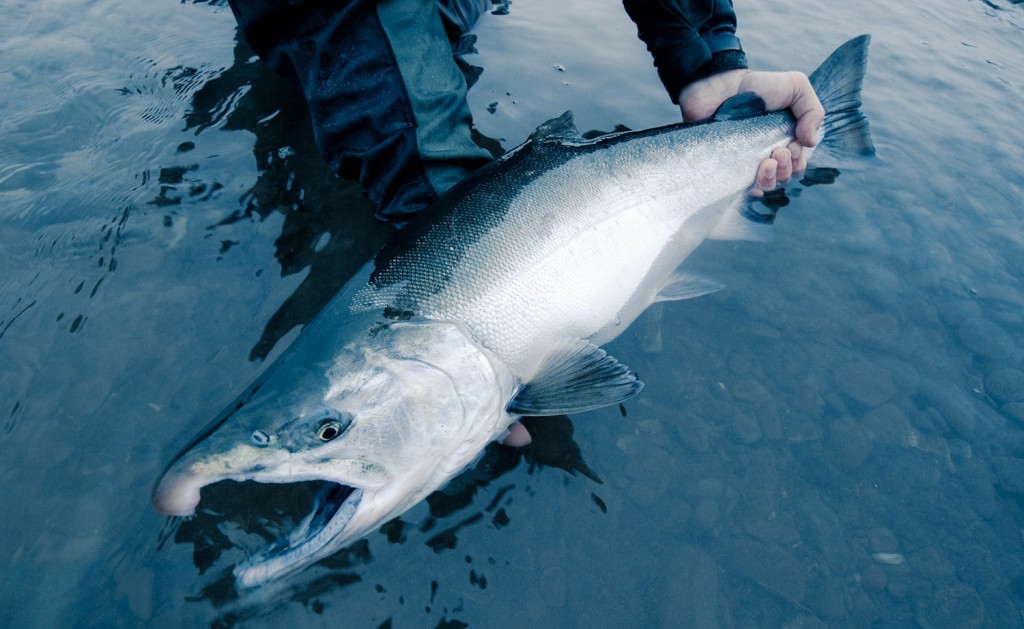
Is Aquiculture Wrong?
I got into a discussion with a friend the other day that put a burr under my saddle. We were talking about what fish is OK to eat and what isn’t. Not in the way that I refuse to eat a catfish from the Chattahoochee but rather how no one should be eating wild steelhead. My friend, who is not a fisherman, asked “what about farm raised fish?” Without thinking about it I said, “sure, that’s fine”. He then went on to explain that he did not eat farm raised fish because it was cruel to take a fish that was meant to be free and confine it in a pen. ( I’m not going to dwell on this idea for too long for reasons that I think are obvious. If that’s the story you want to hear, click here! ) I am unashamedly opposed to the idea of causing unnecessary pain and suffering to any living thing but I also understand what these teeth were put in my head for. I could write a couple of thousand words on this but instead I’ll leave it at this. I remember standing on a gravel bar in Alaska watching a salmon struggling in the current. The fish’s tail was missing along with the last eight inches of him. Two trout were following taking turns eating him while he was still alive. My point being, if we are going to get into the business of attaching human emotions like happiness to fish, let’s be sure we’re choosing the correct emotions. Nobody cares about fish more than me, but that’s their nature. If you hold still long enough, they’ll eat you. I’m really not sure what happiness is to a fish but most of them will choose to stay in one spot if there is plenty of food so I’m not worried about the pen.
Still, this got me thinking. Did I give the right answer? Is fish farming OK? With recent outbreaks of Infectious Salmon Anemia in the Pacific Northwest spreading from fish farms and threatening wild Pacific salmon I had to wonder. Hundreds of thousands of farm raised fish escape into the ocean spreading, not only disease, but their scientifically altered genes, wreaking god knows what kind of havoc on wild populations. Sometimes these escapees are non-native species that out compete native fish. In fact, these fish don’t even need to escape to do their damage. With massive fish farms at the mouthes of some of the world’s best steelhead and salmon rivers wild salmon, steelhead and smelt must run a gauntlet of disease every year to spawn. And what of the impact of all those penned up fish on the ecosystem? It’s clearly a mess but what’s the answer?
The world’s rapidly expanding demand for seafood is greater than the oceans can sustain. Popular species like tuna are under immense pressure. Fish size and numbers are way down in the open ocean. Clearly we can’t all eat wild fish. I spoke to
Read More »The Economy of Wraps in Fly Tying
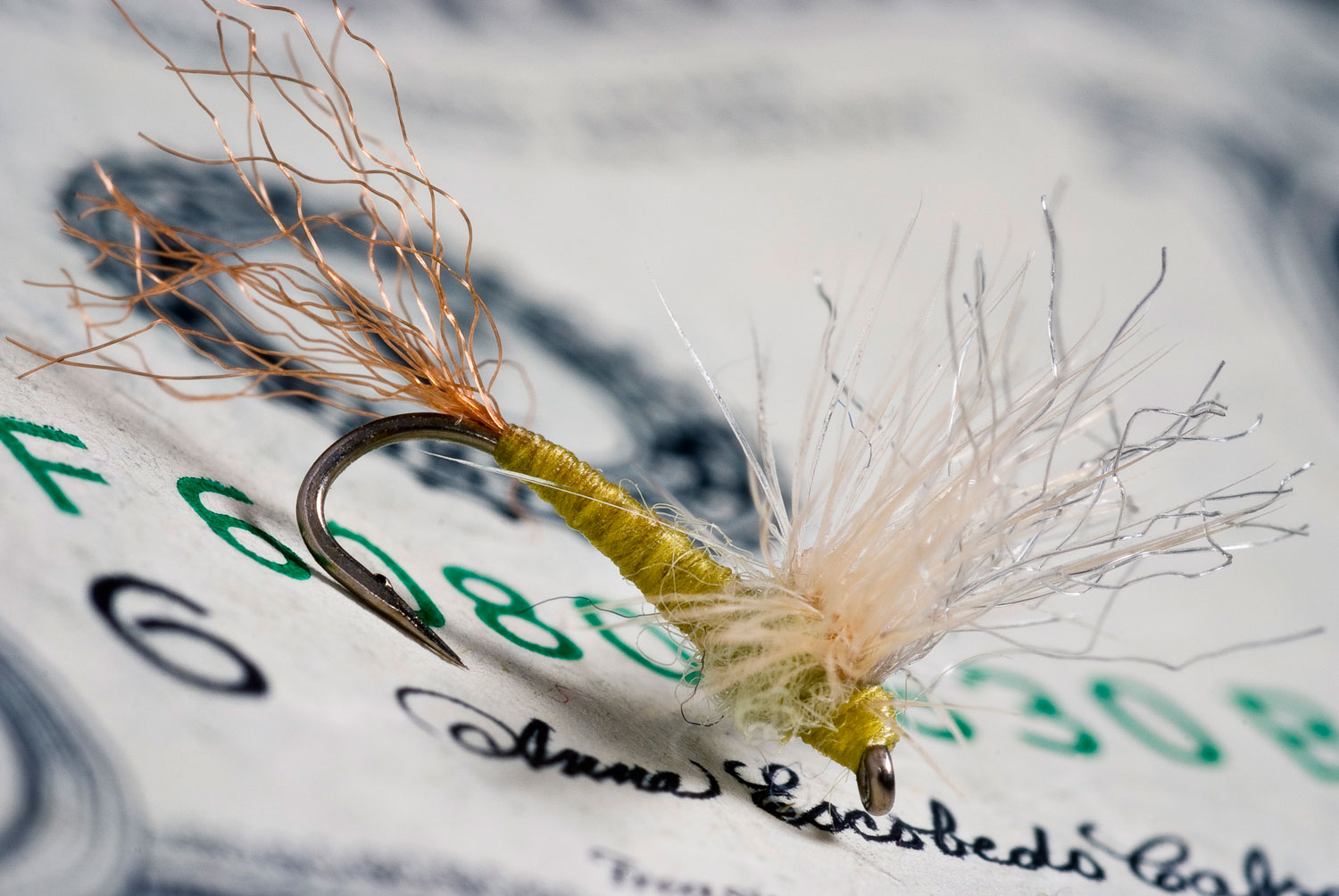
THE HALLMARK OF WELL-TIED FLIES IS NATURAL PROPORTION.
This is never more true than when tying tiny trout flies. Trout are visual feeders and there are three primary criteria that a fly must meet to elicit a positive response. It must match the natural in size, color and profile. Of these three, the hardest to match in tiny flies is profile.
There are several elements to a fly’s profile. It must have the appropriate style of wing and the right size hackle, for example, but where most of us miss the mark is in the proportion of the body. Primarily because most tiers, often including myself, use too many wraps of thread.
Using too much thread builds bodies that are too thick and often lumpy and awkward. It always matters but when tying patterns smaller than size 16 every wrap is critical. Using too many wraps to secure a material will cause awkward lumps in the tiny profile which make the fly look unnatural. That can cost you a discerning fish.
HERE ARE SOME TECHNIQUES THAT WILL HELP YOU TIE MORE NATURAL FLIES BY SPARING THE THREAD.
Make a plan
It’s easy to become task oriented when tying. When you focus only on the material you are tying in, you end up doing repetitive tasks. Plan ahead. Think of the fly as a whole and take a minute to think it through before you tie. You can often catch in several materials with a single wrap each, then secure them together as you wrap up the hook shank.
Catch materials in early
Materials like ribbing wire can be caught in as you first wrap your thread down the hook shank. This conserves an entire layer of thread. There’s no need for a thread base to tie the wire into, because once it’s wrapped around the body, it can not be put under enough pressure to be pulled free.
Lock materials with alternating wraps
Once you’ve wrapped a hackle or body material it’s common to use too many wraps to secure it. The most effective way to lock material in is
